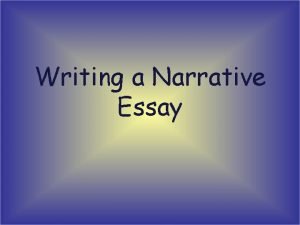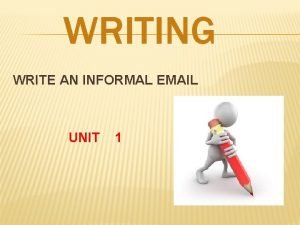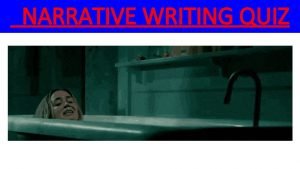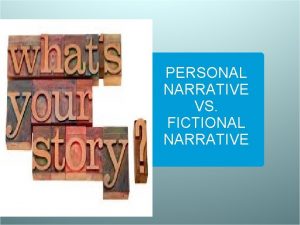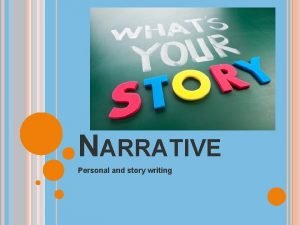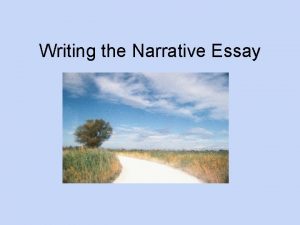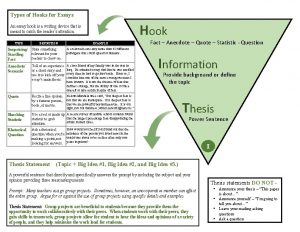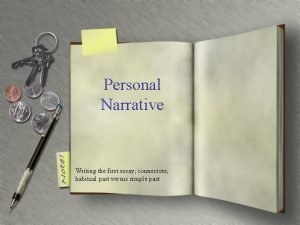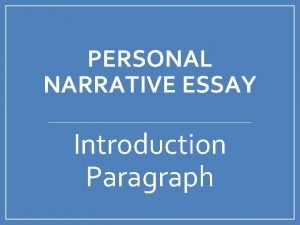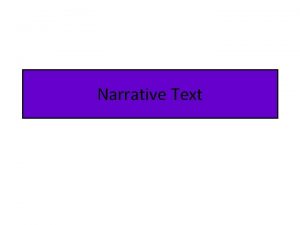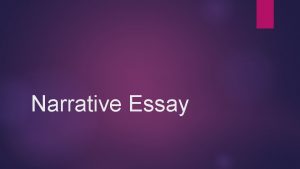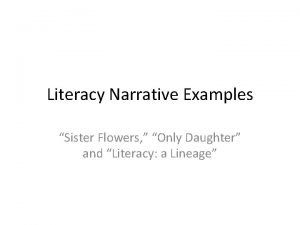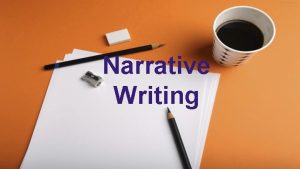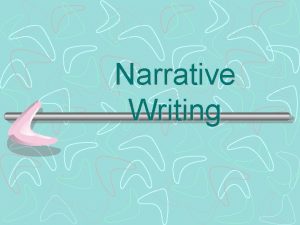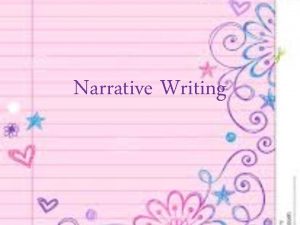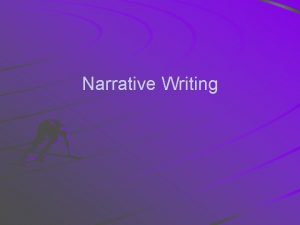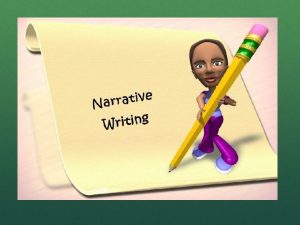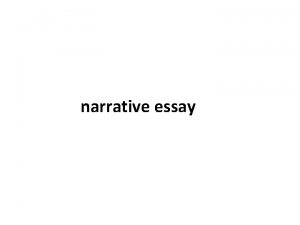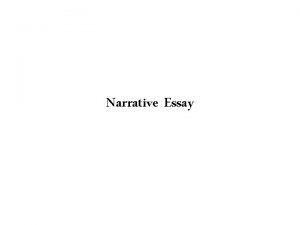Narrative Writing overview When writing a narrative essay













- Slides: 13

Narrative Writing overview


• When writing a narrative essay, one might think of it as telling a story. These essays are often anecdotal, experiential, and personal—allowing students to express themselves in a creative and, quite often, moving ways. • Here are some guidelines for writing a narrative essay. • If written as a story, the essay should include all the parts of a story. • This means that you must include an introduction, plot, characters, setting, climax, and conclusion. • When would a narrative essay not be written as a story? • A good example of this is when an instructor asks a student to write a book report. Obviously, this would not necessarily follow the pattern of a story and would focus on providing an informative narrative for the reader. • The essay should have a purpose. • Make a point! Think of this as thesis of your story. If there is no point to what you are narrating, why narrate it at all? • The essay should be written from a clear point of view. • It is quite common for narrative essays to be written from the standpoint of the author; however, this is not the sole perspective to be considered. Creativity in narrative essays often times manifests itself in the form of authorial perspective. • Use clear and concise language throughout the essay. • Much like the descriptive essay, narrative essays are effective when the language is carefully, particularly, and artfully chosen. Use specific language to evoke specific emotions and senses in the reader. • The use of the first person pronoun ‘I’ is welcomed. • Do not abuse this guideline! Though it is welcomed it is not necessary—nor should it be overused for lack of clearer diction. • As always, be organized! • Have a clear introduction that sets the tone for the remainder of the essay. Do not leave the reader guessing about the purpose of your narrative. Remember, you are in control of the essay, so guide it where you desire (just make sure your audience can follow your lead).

Why Narrative? • Good writing practice…. • College essay submission practice!

Narrative vs. Story-telling • So it doesn’t sound too sing-songy: ▫ ▫ ▫ Order conflict/ Plot TENSION Build a particular purpose (resolution and message from the author-you)

Autobiographical Incident • Have a point • Place your story (not real time) don’t include dull moments • Maintain a consistent POV (I) or (he, she) • Insert appropriate details

Narrative Order 1. 2. 3. 4. 5. 6. 7. 8. 9. Analyze prompt Brainstorm events related to prompt-circle map Create an order- tree map Orally rehearse narrative w/ someone Write an intro: hook/grabber 1 main event Flow map w/ 3 main events Write conclusion Write narrative using map as guide

Resources • OWL Purdue

Possible Prompts • Embarrassing moment • Person that influenced your life • Finally being able to do something and what you had to do to succeed • A time when you had to prove yourself • A lesson learned from your parents • An unforgettable experience at school

Home Run

Original recording 1908

Home Run • • • Sensory details? Action packed One moment- slowed down (not real time) Zoomed in on the “moment” Takes you there

Literary Techniques • Step 1: Get out that wksht (literary devices) • Step 2: get the essay • Step 3: read to yourself : write all over the essays: hi-light & take notes in margin • Step 4: read aloud • Step 5: in NB w/ partner SOAPSTone & list all the techniques ▫ Flashback ▫ Foreshadowing ▫ Sensory details (touch, taste, smell, sight, sound) ▫ Setting ▫ Plot- tension ▫ Allusion, alliteration, etc. (wksht) **Answer in NB: What is unique about this moment? How did the writer utilize these details in the moment? What part really stood out to you? What part did you find a connection to? What techniques are you going to use in your narrative?
 Writing a narrative application essay quiz
Writing a narrative application essay quiz Narrative essay purpose
Narrative essay purpose Informal mail
Informal mail Personal narrative quiz
Personal narrative quiz Narrative vs story
Narrative vs story Difference between narrative and story
Difference between narrative and story Narrative essay definition
Narrative essay definition Whats a narrative essay
Whats a narrative essay 5 types of essay hooks
5 types of essay hooks Connectors essay
Connectors essay Narrative essay introduction paragraph
Narrative essay introduction paragraph Narrative text is a
Narrative text is a Personal narrative essay examples
Personal narrative essay examples Literacy narrative essay examples
Literacy narrative essay examples

